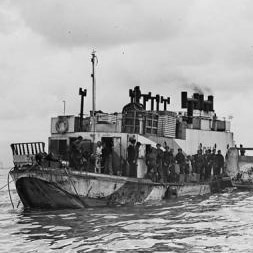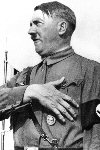I Was There! - We Opened the Fourth Front in Southern France
The War Illustrated, Volume 8, No. 189, Page 281, September 15, 1944.
British, U.S. and French troops landed on the Riviera on August 15, 1944 – and within a week 2,000 square miles of territory in the South of France had been liberated. Maurice Fagence of the Daily Herard, who was about the flagship, tells the story of the preliminary bombardment.
I have just seen the fourth front open in the chilly, misty hours of dawn. We were due to land our fist men at 8 a.m. At 8.51 I can write that they are pouring on to the beaches. At this early hour there seems astonishingly little response from the enemy. He may well be lying doggo, but I prefer to believe his coastal defences are either stunned or obliterated by the air-sea bombardment that is still shaking our flagship like a tin toy in a bath.
More than 1,000 Allied ships lurked in the offshore mists when over the loudspeakers came the warning: "Now, here it is", followed by a command that pinned the gunners to the guns and infantry to their stand-by points. American ears paid no undue attention to the first warning. It is the traditional preface to an American naval order, but to us British it sounded a well-chosen piece of Americanism to describe – what everybody engaged in this vast operation believes it to be – the last challenge to Hitler to find reserves to resist the grand assault that is going to finish the war.
Well, here it certainly is. Afloat in a sea aflame with orange fire and acrid with cordite fumes, and semi-stupefied by the roar of it all, I try to sort out my impressions. These ships around me assembled at a dozen different points in the Mediterranean to fox the enemy. For days and nights they steamed. Yesterday, when we were well knit into a monster fleet, Admiral Cunningham and General Maitland Wilson skidded around us in the fastest, slickest British destroyer afloat with the message that what we were going to do is destined to make history, and might prove the final blow to the enemy.
I talked on the bridge with the admiral commanding this particular naval force, which is concerned with the central part of a ten-mile front. "They've promised me bombardment by 1,300 bombers just before the attack, and they've even promised me bombs that make no dust", he said. The first sign of battle came from the enemy-held coast when a signal light hissed into the sky. We were still watching the spot when an American destroyer nearby spat smoke and a shell towards the coast.
British destroyers opened up just as vehemently, then more Americans joined in. Finally the great shadowy shapes of battleships, almost hidden in the mist farther out to sea, began to roar out broadsides. Destroyers sailed up saucily towards the shore and poured in close-range stuff. And those 1,300 bombers weighed in, giving us a close-up picture of what a Berlin bombing must look like. The bombers left, and it was the turn of the rocket ships. They threw sheets of fire that made even the oldest warhorses jump until the noise died down just in time to give our ear-drums a reprieve as the first wave of infantry went ashore.
It is now 9.15, and I hear the voices of beachmasters, calm, confident voices, telling what size boats can now get in with little difficulty. At 9.30 we ourselves ease towards that strangely quiet beach. An American tank lies wrecked on the beach, victim of a coastal mine which our rocket ships failed to detonate. A cloud of dust rises from where a small squat beach-house had stood. Some minutes before, the Germans opened fire from this house on a tiny British flak ship standing offshore.
So a destroyer butted in like a big brother. Just one blow and the column of dust shot up. From a hotel high on the coast that rises to some hundred feet inland a group emerges with a white flag. The weak response of the enemy is astonishing, inexplicable and welcome. As I hand over my message for transmission a hundred prisoners are coming down to our beaches and the seventh wave of our infantry leap from their barges.
Previous and next article from I Was There!
I Was There! - They Bake 1,000 Loaves a Day for Invasion Craft
Admiral Sir Bertram Ramsay, Allied Naval C.-in-C., has sent a message of congratulation to the men in the landing ships engaged in the vitally important work of building up supplies in Normandy. Here
I Was There! - I Saw the Mad Colonel of St. Malo Surrender
Having sworn to defend St. Malo, in Normandy, to the last drop of blood, Colonel von Auloch headed an ignoble procession of 605 Germans to surrender – the day after Hitler had presented him with the
Index
Previous article
The Story Behind Britain's Vast Radio Blitz
Every hour of the 24 the air over Europe is charged with the War-Voice of Britain sent out by the B.B.C. In frantic endeavour to quell the unceasing Voice from London the Nazis are devoting more ti
Next article
I Was There! - I Saw the Mad Colonel of St. Malo Surrender
Having sworn to defend St. Malo, in Normandy, to the last drop of blood, Colonel von Auloch headed an ignoble procession of 605 Germans to surrender – the day after Hitler had presented him with the





